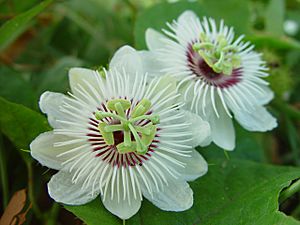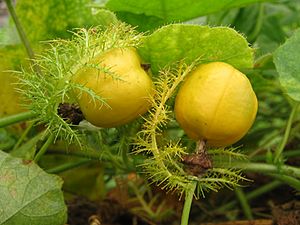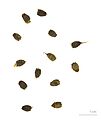Passiflora foetida facts for kids
Quick facts for kids Passiflora foetida |
|
|---|---|
 |
|
| Flowers | |
 |
|
| Fruits | |
| Scientific classification | |
| Genus: |
Passiflora
|
| Species: |
foetida
|
Passiflora foetida is a type of passion flower that grows naturally in the southwestern United States (like southern Texas and Arizona), Mexico, the Caribbean, Central America, and much of South America. It has also been brought to many other warm, tropical places around the world, such as Southeast Asia, South Asia, Hawaii, Africa, and The Maldives.
Like other passion flowers, it's a vine that creeps and climbs. It also grows an edible fruit. The name foetida comes from Latin and means "stinking." This refers to the strong smell the plant gives off if its leaves are damaged. This plant can grow in dry areas but prefers places that are a bit moist. In some regions, it grows so well that it can become an invasive species, meaning it spreads quickly and can take over. People have also used this plant in traditional medicine for a long time.
Contents
What the Stinking Passionflower Looks Like
The stems of the Passiflora foetida are thin and look like wire. They are covered with tiny, sticky yellow hairs. As the plant gets older, its stems become more woody. The leaves usually have three to five lobes and are also sticky and hairy. If you crush these leaves, they release a strong smell that some people find unpleasant.
The flowers are usually white to pale cream, or sometimes pink to light purple. They are about 5–6 cm wide. When the fruit is ripe, it's round and about 2–3 cm across. Fruits from white-flowered plants are yellow, and those from pink-flowered plants are red. There are actually more than 50 different types of this plant! Inside the fruit, there are many black seeds surrounded by a soft pulp. Birds enjoy eating these fruits, which helps spread the seeds.
How it Catches Insects
Passiflora foetida is special because it can trap insects on its bracts. Bracts are like small, leaf-like structures near the flower. These bracts release a sticky substance that also contains special chemicals that can break down things. This helps protect the young flowers and fruits from being eaten by insects. Scientists are still studying if the plant actually gets food from the insects it traps, but it is considered a protocarnivorous plant. This means it might be on its way to becoming a true carnivorous plant, like a Venus flytrap.
Animals and the Stinking Passionflower
The Passiflora foetida plant is very important for the Gulf fritillary butterfly (which is called Agraulis vanillae). The caterpillars of this butterfly eat the plant's leaves, and the adult butterflies drink nectar from its flowers.
Farmers in northeastern Brazil have sometimes said that Passiflora foetida can be harmful to their animals. An experiment with goats showed that if they ate a lot of fresh leaves, especially during the dry season, they could get sick. This is because the plant contains certain natural chemicals that can be harmful in large amounts.
What People Use it For
The fruits of Passiflora foetida are about the size of a ping pong ball or a small kumquat. Inside, they have a bluish-white pulp that tastes a little sweet and has a delicate flavor. In the Philippines, people have many local names for the fruit, like marya-marya (meaning 'Little Mary'), kurombot, utot-utot, and santo papa (which means 'holy father' because it looks a bit like the Pope's mitre, a special hat).
Young leaves and the tips of the plant can also be eaten. In Vietnamese folk medicine, people use the dry leaves to make tea. This tea is believed to help with sleeping problems, and also to treat itching and coughs.
Images for kids
See also
 In Spanish: Mburucuyá fétido para niños
In Spanish: Mburucuyá fétido para niños








